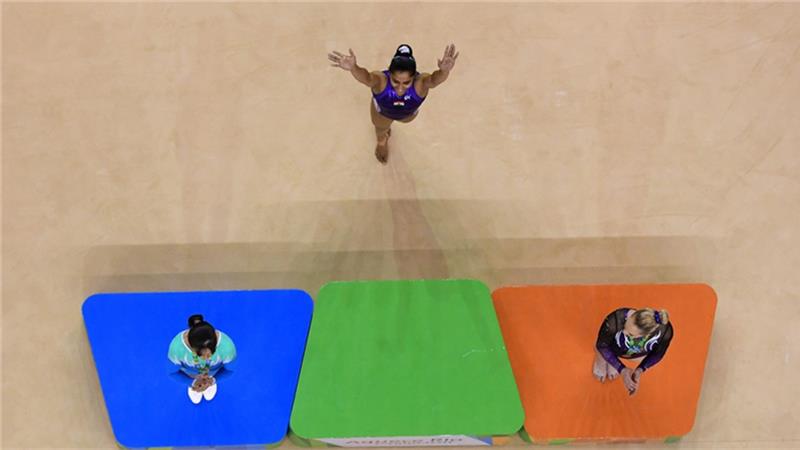
New Delhi, India – “Deepa, medal leke aana (Deepa, come back with the medal),” Indian Prime Minster Narendra Modi told Deepa Karmakar a month before the Rio Olympics while meeting the members of the Indian contingent in Delhi.
Karmakar, in her Bengali-accented Hindi, responded to Modi with a smile, saying: “Sir, I’ll try my best to get the medal.”
Karmakar is a unique athlete, the country’s first female gymnast at the Olympics – the 11 previous gymnasts have all been male.
The 22-year-old is a five-time national gymnastic champion. Her biggest moment arrived in Glasgow at the 2014 Commonwealth Games. She was eighth going into the finals, but attempted the highly difficult Produnova for the first time in a competition, bagging herself a bronze medal, a first for an female Indian gymnast.
Another bronze followed at next year’s Asian Championships in Hiroshima but a month later, competing against the best in artistic gymnastics, Karmakar finished an excruciating fifth at the World Championships.
The first four automatically qualified for the Olympics so her final shot was to better everyone else came at Aquece Rio Test Event that was held in April this year.
She was lucky to make the final shortlist as the second reserve after North Korea withdrew. Aided by the Produnova again, Karmakar propelled herself to gold in the vault and sealed her ticket to Rio 2016.
Karmakar was born and brought up in Agartala, capital city of Tripura, the second smallest state in India’s northeast. Gymnastics has deep roots in Tripura – it was introduced by a journeyman coach Dalip Singh in the mid 20th century.
Sport has been an integral part of the northeast and the most famous female athlete to emerge from these parts has been the Olympics boxing medallist Mary Kom.
Karmakar was encouraged to take up the sport by her parents. Her father, Dulal is a former gymnastics enthusiast and currently a weightlifting coach, asked her to pursue gymnastics.
When she was first sent as an eight-year-old to Bishweshwar Nandi, a former three-time national champion, Karmakar was not so keen on gymnastics. She had also come flat footed, a problem that did not take Nandi too long to fix.
Anger management
It was late July afternoon when Al Jazeera met Karmakar at the IGI Complex in Delhi.
Like most gymnasts Karmakar is not that tall – around 5ft in height
That day she weighed 50kg, a few more than Nandi likes. The heat and the lack of a breeze inside the complex made things uncomfortable.
Karmakar was struggling to get her rhythm correct. She kept asking Nandi to correct the positioning of propelling board. Silence and sighs made the atmosphere a bit tense.
 |
| The 22-year-old Karmakar is a five-time national gymnastic champion [Getty Images] |
The pair did not talk much as Karmakar got landings wrong and at times, when she managed to land on her feet, she was ungainly.
“When she is angry in a positive way she can do a lot, and has done it,” Nandi told Al Jazeera.
Like any good coach, he challenged Karmakar by taunting her – in Bengali.
“I told her jump fast, touch the vault swiftly, push yourself more. She got angry and said ‘I’ll show you now’.”
Karmarkar was restless because she had a point to prove. At about the tenth jump, she launched herself, touched the vault quickly, landed perfectly on the balls of her feet, maintained the position for a couple of extra seconds and raised both hands to round off a near-perfect Produnova.
A smile lit up her face. Nandi let out his own joy by clapping.
Lacking adequate gymnastics infrastructure
Karmakar, who is single-minded, had told her parents to allow her to study in a Bangla-medium school, which was flexible and allowed her to devote more time to gymnastics at a young age.
Her parents wanted both daughters – Karmakar and older sister Puja – to study in an English-medium school.
 |
| Follow our Rio 2016 coverage |
But Karmarkar’s wishes were granted and once she won the junior nationals for the first time and her interest in the sport grew. When Ashish Kumar became the first Indian gymnast to bag a medal at the 2010 Commonwealth Games, Karmakar’s determination soared.
The road to a medal, especially in a sport not popular in India, is never easy. Karmakar did not have the same training facilities, infrastructure or support like her competition from USA, Russia and Romania.
“The elite gymnasts have always relied on a scientific system which was established decades ago,” Nandi said. “It’s difficult to improve. In India, gymnastics is not popular. So it is not easy.”
It definitely has never been easy for Karmakar who grew up training in places without the proper equipment, where she had to land on hard surfaces or platforms made up of anything that was soft and spongy.
At the Vivekananda Byamagar, the gymnasium where Nandi and Karmakar started gymnastics, rainwater would seep through the roof on to the floor. Instead of slipping into the stream of frustration, Karmakar steeled herself psychologically to leap over all difficulties.
 |
| Learning from the best – Karmakar had the opportunity to meet cricketer Sachin Tendulkar (right) [Al Jazeera] |
Karmakar also became caught up in the ugly tug of war between rival factions governing the Indian Gymnastics Federation.
After the 2015 World Championships, she was asked her to participate in two separate nationals. With a year to go before the Olympics, the youngster was being asked by administrators, who needed to support her, to take sides.
“Pain is a part of my life,” Karmakar said.
“But if I’m too serious, I can’t focus on my training. The more repetitions you do, the more comfortable it gets.”
Karmakar has made it past the qualifying rounds in Rio but the gymnast and coach stress that a medal is not their aim and not realistic.
But in a country where many on the street would find it difficult to pronounce gymnastics, Karmakar, who turns 23 on August 9, has pushed the boundaries to arrive at the biggest stage of her life.
In the realms of Indian sport, her story is already extraordinary.
[Source:- Alazeera]



